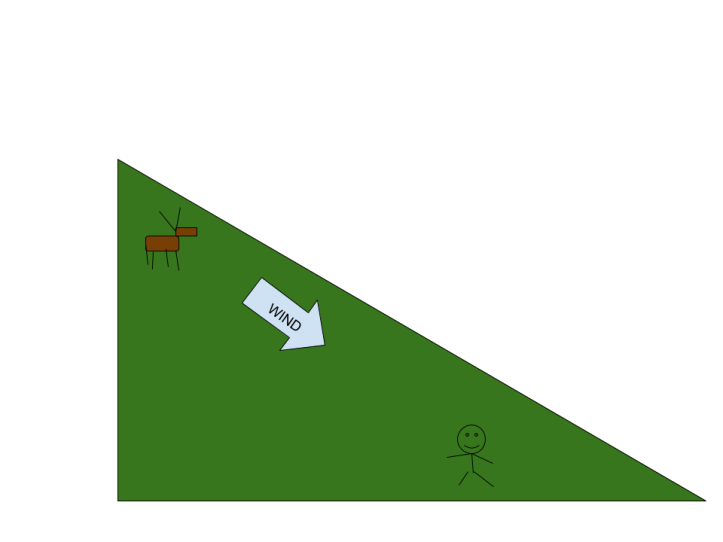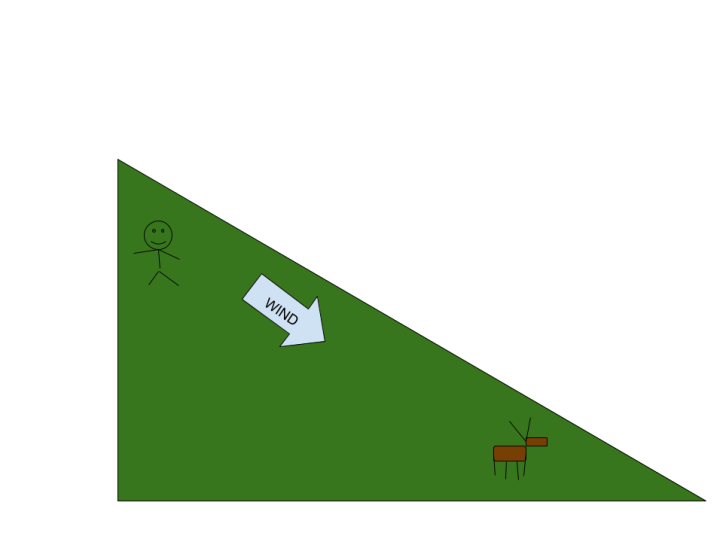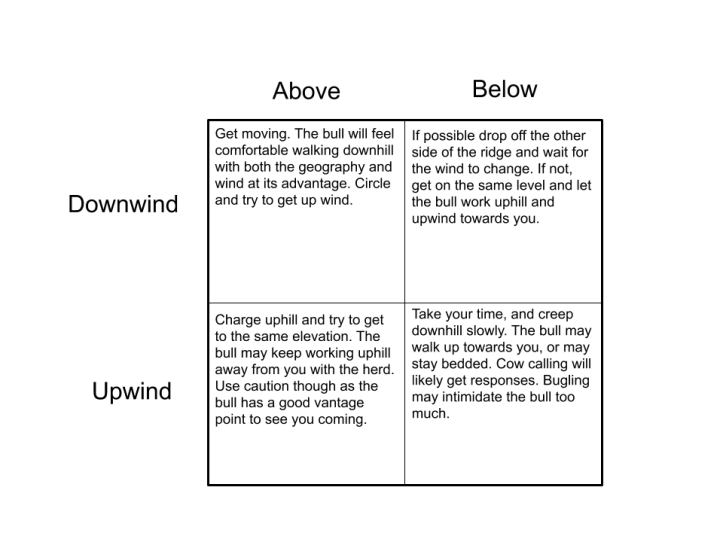Most hunters have a systematic approach when they hear a bugle. Many base their decisions on how intense the bugle sounds and its distance. Personally, I find myself in one of four scenarios depending on the wind direction and whether the bugle comes from uphill or downhill of my position. In this blog I will explain each opportunity and what factors to keep in mind.
Predicting Wind Direction
Thermals drop in the morning until the sun warms the valley, then the air begins to rise. The breeze will continue uphill throughout the day. However, in cool areas, such as shaded northeast slopes, the thermals switch and flow downhill during the afternoon, but for the most part this happens after sundown. Pay attention when traveling up fingers and drainages that make up portions of larger canyons. As the wind moves downhill it will also flow downstream along the overall gradient of the valley. As a result the wind won’t travel straight downhill or uphill but at a slight angle. Lastly, note the time each morning when the wind shifts and keep it in mind as you hunt.
Uphill Upwind

This scenario presents itself often. Because bulls head towards their bedding areas in the mornings, and feel more comfortable bugling from above, hunters will hear a bull bugle uphill from them with the thermals dropping downhill. You will have the wind at you advantage, but act quickly because the herd will keep moving. Often the bull will continue bugling but remain with the cows as they head for bedding areas. Work quickly to close the gap, but remember the bull will have a good vantage point to see you coming. Cut to the side of his location and climb to the same elevation. Cow or calf call to imitate a forgotten member of the herd in order to maintain an idea of his location. Hold off bugling until within 100 yards. A bugle too early may cause the bull to push the herd even faster uphill. After bugling the bull will attempt to get above your position or even charge straight towards you. In either case he won’t have a chance to catch your scent. If you see the bull attempting to get above you, run uphill ten to twenty yards for a shot opportunity.
Downhill Downwind

Probably the worst scenario, but it does happen a fair amount in the morning when walking ridges with dropping thermals. A bull responds from below and a hunter can’t drop down to the bull without getting winded. If the thermals will switch soon a hunter can drop off the far side of the ridge and wait for the change, then hop back over and creep in on his bed. If the wind isn’t going to switch soon, a hunter must run back down the ridge before flanking and coming from the side or below. The herd will probably continue moving and keeping tabs on their location will present a challenge. Essentially, you’ll need to get to a downwind position.
Uphill Downwind

This scenario occurs most often later in the day after the thermals have switched and the bull is either bedded or raking a tree. The wind will not switch any time soon, so a hunter can’t wait him out. Because the herd has bedded the bull may feel comfortable walking downhill to check on your position. Keep quiet and work up the gorge and all the way above the bull. Move quickly because once again he will have a good vantage point and the wind in his favor. Also, move back in the direction you came from as the bull didn’t wind you on the way in, and won’t catch your scent as you head back in that direction.
Downhill Upwind

Hearing a bugle from downhill upwind will provide a great opportunity to harvest a bull. Most likely you have been traveling a ridge late in the morning. Listen carefully for the sound of the bull breaking branches. He could be raking a tree or walking uphill towards you. If the bull begins to rake a tree, move in quickly for the shot. In the ideal situation the bull has bedded and you can take your time to stalk slowly downhill. If you hear the bull moving uphill imitate a cow. Throwing an aggressive bugle at a bull that stand below you and can’t test your wind will make the bull wary to come any closer. Bulls prefer to stand above their adversary, which makes calling elk uphill more challenging. You should receive responses from cow calls and can play a yoyo type game of moving up and down the hill to get him to come to you.
Conclusion
Obviously each scenario has been simplified and other variables, such as the week of the season and the intensity of the bugle, will play a role. I hope this helps you understand a bit more about elk hunting and how to use thermals to your advantage. Good luck, Stu
